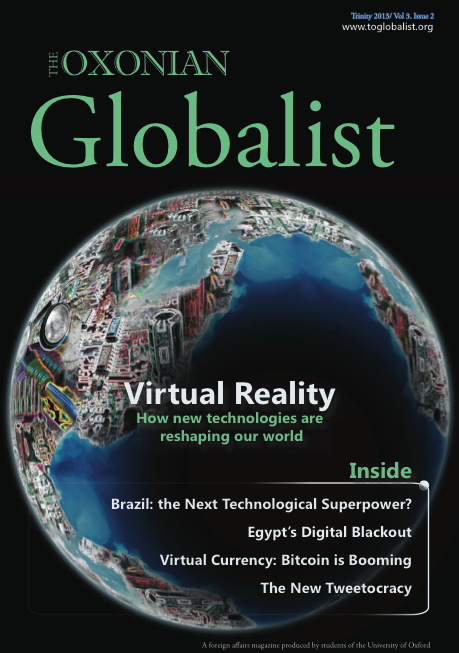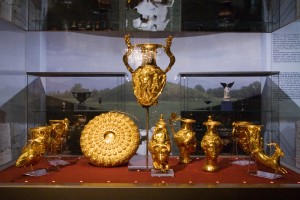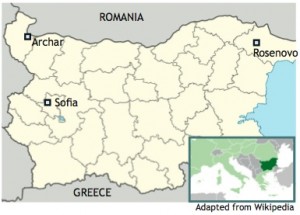SURROUNDED by the quiet streams and oak groves of the Strandja Mountains in south-west Bulgaria, the village of Rosenovo is home to 30 people who live bereft of standard luxuries, such as running water and paved roads. This is where my father was born. When he was a boy, he discovered the ruins of an ancient fortress on a hill nearby. Two millennia ago, a division of Roman soldiers controlled an area that stretched for 30 km to the city of Debeltum. I visited the site three years ago to accompany my father on a trip through his childhood memories. There, I found traces of plunder. I vividly remember standing over a gaping hole in the ground, almost two metres deep and four meters wide, full of tattered pieces of stone. Aggressive digging had revealed the outline of a small rectangular chapel with a rounded apse. I reached into the rubble and picked up a fragment of a painted mural about the size of my cupped hands that portrayed an important historical figure – perhaps an emperor or a saint. The mural had been shattered.
I experienced an art historian’s tragedy. Careful excavation might have revealed new insights into early Christianity in these lands. The historical foundations could have disclosed information about Roman defense strategies in this province. But this evidence has been all but lost, destroyed beyond recognition by organised human action.
Today, approximately 300,000 people engage in unregulated excavation for ancient Roman, Greek, and Thracian artifacts. The archeological gold rush began after the fall of the Communist regime in 1989. The early years of democracy and a free market in post-communist Bulgaria brought food shortages, hyperinflation, a defunct judicial system and rampant treasure hunting. Over the past two decades, thousands of years of history have been destroyed in Bulgaria. Only now is the government beginning to take up the challenge of regulating excavation and preserving Bulgaria’s ancient heritage.
The Vandals
Ratiaria is a city on the opposite end of Bulgaria from the Strandja Mountains, in the north-west. While this is the poorest area in Bulgaria, it is built upon one of the richest archaeological sites on the European continent. Unlike other cities from the Roman era, it stands buried exactly as it was abandoned in the fourth century AD. The richness of urban life in the Roman Empire has been preserved there for centuries; foundations of buildings, streets, household objects, burials and temples lie untouched beneath the surface. A man from Archar, the village nearest to Ratiaria, admits in an interview that he has unearthed and sold artifacts here. Many of his fellow villagers, for whom digging is one of the few available sources of income, supplement the meager earnings from their day-jobs with the proceeds generated from trading artifacts.
Archaeologist Krasimira Luka calls Ratiaria “the local Klondike.” Most locals use small tools, such as shovels of their bare hands, to search for pieces. Those with the means to do so use bulldozers and explosives to excavate larger antiques. In either case, information used to date the objects is inadvertently destroyed during the process. The dynamics of treasure hunting mean that only objects that yield significant profits – such as precious metals, luxury vessels, jewelry, statuaries, and stone reliefs – tend to survive this process of “natural selection”. Unmarketable artifacts are abandoned or destroyed. Many Bulgarian locals locals consider collecting samples of mortar and domestic wall paint a pointless exercise while valuable coins, jewelry pieces, and small statues lie untouched beneath the earth’s surface. For this reason, intangible, though archeologically valuable information, such as evidence relating to city-planning or specific architectural styles, is often completely lost. In Ratiaria, the economic incentives govern the politics of ancient art.
The Villains
The promise of greater profits persuades many diggers to export antiques to markets where they can fetch the highest price. On March 7th 1994, Svetozara Kirilova, a flight attendant on a Balkan Airlines flight from Sofia to New York was asked to forward a small suitcase to an individual in the United States. Suspicious of the contents, she opened the suitcase to discover what was later reported as “over 3000 silver, copper, and bronze Roman coins, plaques, fragments, earrings, bracelets and other valuables” valued at almost £45,000. By law, all of the artifacts belonged to the Bulgarian state, and a trial ensued accusing four people as the organisers of the illegal export. However, four years later, Kiril Ivanov, district prosecutor for Sofia City, discontinued the trial. In 2001, it was reported that the confiscated suitcase had disappeared; nobody could determine the location of the coins. In 2009, a newspaper reported that the documentation about the trial had disappeared. After a journalist requested access to the court records, it turned out they were no longer extant. In the absence of strong law enforcement, criminal networks of diggers and traders have evolved into a treasure-hunting mafia. The judicial system had failed to protect the “national” valuables; they were not more secure under its custody than they were as contraband to the United States.
Ministers can do little better. Stefan Danailov, then-Bulgarian Minister for Culture, sent an official letter to the auction house Christie’s in London asking them to stop the auction of a silver dish of either Roman or Byzantine origin. The artifact was illegally looted near the town of Pazardzhik in 1999, Danailov claimed, and it belonged to Bulgaria. Christie’s replied that the dish was exported from Bulgaria to the UK back in 1903, and was now legally part of the Stanford Place Collection. Even when a man from Pazardzhik stated he was the one who found the plate with his metal detector, the auction house did not consider returning the object. Yet Christie’s auction house raises a fair objection to the minister’s claim. Many Bulgarian artifacts belong to ancient cultures whose heritage is spread over the territories of different nations today. Roman antiques, in particular, are mobile and international by nature; from coins to column capitals, their artifacts present a unified style that was used by the empire authorities to export their influence to the most distant provinces. Why Bulgarian state ownership? Why not Italian or (as Christie’s wanted) private ownership?
The Hero?
Admittedly, some collectors are making a considerable effort towards preserving ancient artifacts for Bulgaria. The figure of the philanthropist-collector is epitomised by Vasil Bojkov, a Bulgarian businessman with a fondness for Thracian treasures. Bojkov has registered his collection with the Bulgarian Museum of Natural History; he is one of only 200 collectors to comply with an ultimatum that requires such officiation. He is also preparing an exhibition of rare silver and gold Thracian rhytons: royal drinking vessels of cast metal sculpted in the shape of animal heads. In a public statement, he said: “The Cultural Heritage Law and its enforcement by the state administration leave Bulgaria outside of the European museum network. It must be known that the collector is not a treasure hunter, but rather a guardian of the national heritage.”
In some cases, artifacts fair better in private collections like Bojkov’s than in museums. Typically, private collectors have greater access to suitable funding for research and conservation than museum curators. A museum internship in a small Bulgarian town led me to a leaky basement where stacks of historic paintings from the Socialist era were slowly decaying from the effects of mould damage. Limited state funding prevented management from purchasing proper facilities to preserve these works. For this reason, private collectors tend to resist complying with orders made by the government to confer what they believe is their rightful property.
While Bojkov may not be a treasure-hunter, chances are that his treasured rhytons were acquired illegally. In April 2009, Bulgaria passed the Cultural Heritage Law, which requires any sale of cultural property purchased legally to be registered with the state, and offered first to the Culture Ministry for purchase by the national collections. If the rhytons were purchased legally, then any sale that Bojkov made would have been registered by the state and likely (given the objects’ cultural worth) seized by the government. The law as it stands is weaker than its original version, which mandated that collectors provide documentation for all objects in their collection that possessed significant cultural value to Bulgaria, regardless of whether the items were involved in a transaction. This law was criticised by archeologists, who claimed the mandate would force otherwise honest collectors to produce fraudulent documentation, and by collectors, who considered the law too intrusive. The constitutional court agreed with collectors and declared the provision unconstitutional. Consequently, the remaining statute provides collectors with an incentive to hoard their pieces, lest the government confiscate their artifacts during a sale.
Bulgaria is attempting to negotiate a compromise between a model of total government control inherited from Socialist era and the market approach pioneered by capitalist economies. Already, the government can point to some modest success. Last year, police brought a record number of legal actions against treasure hunters. Private homes were searched and hundreds of artifacts were confiscated. However, progress is inhibited by the legal onus placed on the government to demonstrate its right to ownership. The process of staking a claim remains cumbersome. The government must establish not only that Bulgaria is the most probable place of origin for a certain object, but also produce specific evidence of when and where the object was unearthed. As demonstrated by the situation in Ratiaria, such records are often impossible to obtain.
Bulgaria’s relics, both above and below the earth’s surface, deserve protection. As long as the antiques trade remains lucrative, market demand will continue to provide a driving force for illegal excavation in the future. In response, the Bulgarian government should prohibit archeologically destructive practices and prosecute offenders. In addition, using a delicate cocktail of market regulation and state controls, the government must work with collectors to protect Bulgaria’s existing antiques. Only then will academics be able to piece together the narrative of a country whose artifacts trace more than 7000 years of history.






